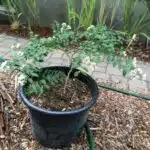Summersweet is a popular shrub that boasts fragrant and beautiful blooms, making it an ideal addition to any home garden. Known for its ability to thrive in moist soil and partial shade, this plant is easy to care for and can be grown in a variety of climates.
Growing summersweet requires some basic knowledge of soil types, watering techniques, and pruning methods. With the right approach, you can enjoy stunning blossoms that attract bees and butterflies while adding visual interest to your outdoor space. In this article, we will provide a comprehensive guide on how to grow and care for summersweet, including tips on selecting the right location, preparing the soil, fertilizing and watering the plant, as well as dealing with pests and diseases. Whether you’re an experienced gardener or just starting out, this guide will give you all the information you need to successfully cultivate healthy summersweet plants that will brighten up your garden for years to come.
Understanding Summersweet: An Overview
Summersweet, also known as Clethra alnifolia, is a deciduous shrub native to North America. It is known for its sweet fragrance and attractive white or pink flowers that bloom in mid to late summer. Summersweet varieties are a popular choice among gardeners due to their low maintenance requirements and adaptability to different growing conditions.
If you’re looking to add some color and scent to your garden during the summer months, then summersweet is an excellent choice. This plant typically grows up to 6 feet tall and wide, making it ideal for both small and large gardens alike. In addition, it thrives in a variety of growing seasons from full sun to partial shade and wet soil conditions.
In terms of cultivation, summersweet plants are relatively easy to care for. They require regular watering during the first few years after planting, but once established, they can tolerate periods of drought. Additionally, pruning should be done in early spring before new growth appears to maintain its desired shape. With proper care and attention, summersweet can provide years of beauty and fragrance for any garden enthusiast.
With its hardy nature and stunning blooms, growing summersweet comes with many benefits. Whether you’re looking for an eye-catching centerpiece or simply want to add some fragrance to your outdoor space, this versatile plant has got you covered. In the next section, we’ll delve deeper into the specific advantages of cultivating this wonderful shrub.
Benefits Of Growing Summersweet
Summersweet is a versatile and attractive plant that can thrive in various conditions. The plant is native to the eastern part of North America and has been used for medicinal purposes for centuries. In recent years, summersweet has become increasingly popular among gardeners and landscaping enthusiasts due to its distinct fragrance, vibrant colors, and low maintenance requirements.
Health benefits associated with summersweet are numerous. The plant contains natural compounds that have anti-inflammatory properties, making it a useful treatment for pain relief. It also contains antioxidants, which help protect against cellular damage caused by free radicals. Summersweet tea is known to aid digestion, soothe sore throats, and reduce fever.
Culinary uses of summersweet are also gaining popularity. Its fragrant flowers can be used to flavor syrups, jams, and jellies. They can also be infused in teas or added as a garnish to various dishes. Additionally, the leaves of the plant can be used as an alternative seasoning for meat dishes or added to salads for a unique flavor profile.
When choosing the right location for your summersweet plant, it is important to consider several factors such as soil type, sunlight exposure, and drainage. Summersweet thrives in moist soil but does not tolerate standing water. It prefers partial shade but can also grow in full sun if the soil is consistently moist. Choosing the right location will ensure that your summersweet plant grows healthy and produces abundant blooms every year.
Choosing The Right Location For Your Summersweet Plant
- Summersweet (Clethra alnifolia) is a deciduous shrub that can grow up to 8 feet tall and wide, and thrives in a full sun to part shade environment.
- The soil should be moist, well-drained and slightly acidic, with a pH range of 5.5 to 6.5.
- Ample sunlight is essential for the growth and flowering of summersweet; plants should receive at least 6 hours of direct sunlight per day.
- Adequate watering is essential for the growth and health of this plant; during the summer, water once or twice a week, and more often in hot, dry weather.
- Mulching can help retain moisture in the soil and protect summersweet’s shallow roots from heat and cold.
- Fertilizer should be applied in spring and late summer to ensure optimal growth and flowering.
Sunlight
Summersweet plants require a specific amount of sunlight to thrive, making it important to choose the right location for them. These deciduous shrubs grow best in full sun to partial shade. When it comes to sunlight requirements, summersweet plants need at least six hours of sunlight each day. They can tolerate some shade, but too much may result in weaker growth and fewer flowers.
To ensure that your summersweet plant receives the optimal exposure time, consider the direction of your garden or planting area. If you are in an area with intense afternoon sun, it may be beneficial to plant your shrub where it will receive some shade during peak hours. Additionally, if you live in a region with hot summers, providing some shading during these months will protect the plant from excessive heat and prevent wilting.
In summary, choosing the right location for your summersweet plant is crucial for its growth and overall health. Remember that these plants require at least six hours of sunlight each day and can tolerate some shade. By paying attention to the direction of your garden or planting area and providing adequate shading during hot summer months, you can help ensure that your summersweet thrives year after year.
Soil
After considering the amount of sunlight a summersweet plant needs, you must also assess the soil quality in your chosen planting area. These shrubs prefer well-draining soil with a pH level between 4.5 and 6.5. The ideal soil type for summersweet is slightly acidic, moist, and rich in organic matter.
To improve drainage, consider amending the soil with sand or gravel to increase permeability. Summersweet plants do not tolerate standing water around their roots, so it is crucial to ensure that excess moisture drains away quickly. Additionally, if your soil has a high pH level, adding sulfur or peat moss can help lower it to the desired range.
Overall, choosing the right location for your summersweet plant requires careful consideration of both sunlight exposure and soil quality. By ensuring that the planting area has well-draining soil with a slightly acidic pH level, you can provide an optimal environment for this deciduous shrub to thrive. Remember to amend the soil as needed to improve drainage and adjust pH levels before planting your summersweet.
Watering
After considering the amount of sunlight and soil quality for your summersweet plant, it is also essential to evaluate its watering needs. Summersweet prefers consistent moisture levels, making it crucial to water the plant regularly. However, overwatering can be detrimental to the shrub’s health, so it is essential to find a balance.
To determine the appropriate watering frequency for your summersweet plant, consider factors such as temperature, humidity levels, and rainfall in your area. During hot and dry weather conditions, you may need to water more frequently than during cooler months or periods of higher rainfall. It is also essential to avoid watering during the hottest part of the day as this can cause excessive evaporation.
When watering your summersweet plant, it is best to use a drip irrigation system or a soaker hose rather than overhead sprinklers. This method allows water to penetrate deeply into the soil while minimizing water loss due to evaporation. Additionally, it is crucial to avoid getting water on the foliage as this can increase the risk of fungal diseases. By following proper watering techniques and adjusting frequency based on environmental conditions, you can help ensure that your summersweet thrives in its chosen location.
Soil Preparation And Fertilization
Soil preparation and fertilization are essential for growing healthy summersweet plants. While summersweet is generally adaptable to various soil types, it thrives in acidic soils with a pH range of 4.5 to 6.0. One common objection to this is that the soil in many gardens may not meet these requirements, making it difficult to grow summersweet successfully. However, with proper soil preparation and fertilization techniques, gardeners can create an ideal environment for their plants.
Before planting summersweet, it is crucial to prepare the soil adequately. Start by removing any weeds or grass from the planting area and adding organic matter such as compost or well-aged manure. Composting options include mixing kitchen scraps with yard waste in a compost bin or using pre-made compost from gardening centers. Organic matter helps improve soil structure and fertility while also providing beneficial microorganisms that help break down nutrients for uptake by plant roots.
Fertilizing summersweet should be done sparingly to avoid excessive growth or damage caused by overfeeding. Gardeners have two main fertilizer options: organic and synthetic fertilizers. Organic fertilizers are made from natural materials such as bone meal, blood meal, and fish emulsion, while synthetic fertilizers are chemically formulated products designed to provide specific nutrients quickly. While both options can be effective when used correctly, organic fertilizers offer long-lasting benefits as they release nutrients slowly over time compared to synthetic fertilizers’ quick-release formulae.
As we have seen, preparing the soil adequately and choosing the right fertilizer is critical for growing healthy summersweet plants successfully. In the next section about ‘planting summersweet: tips and techniques,’ we will explore how to plant your summer sweet properly for optimal growth and beauty.
Planting Summersweet: Tips And Techniques
When choosing a location for planting summersweet, it is important to select a spot that is sheltered from strong winds, has adequate drainage and provides full sun. Planting depth should be 1/2-1 inch below the soil surface. Watering should be done regularly during the first growing season to ensure that the plant is well-established. Soil preparation should include digging a hole that is twice the size of the root ball and incorporating organic matter. Sunlight should be full sun for optimal growth.
Choose A Location
Choosing the right location is essential for the proper growth and care of summersweet. This shrub thrives in full sun to partial shade, making it an excellent option for many gardeners. When deciding on a location, consider the amount of sunlight your area receives throughout the day. Summersweet planted in areas with too much shade may not produce as many flowers, while those planted in full sun may require more watering.
Additionally, summersweet prefers acidic soil with a pH range between 4.5 and 6.5. Before planting, test your soil’s pH level to ensure that it falls within this range. If your soil is not acidic enough, you can amend it with organic matter such as peat moss or compost. It’s also important to ensure that the soil is well-draining to prevent waterlogged roots.
When selecting a location for your summersweet shrub, keep in mind its mature size and allow plenty of space for growth. This plant can reach up to 6 feet tall and wide at maturity, so be sure to plant it where it has room to spread out without overcrowding other plants nearby. With proper location selection and care, your summersweet shrub will reward you with fragrant blooms year after year.
Planting Depth
Now that you have selected the ideal location for your summersweet shrub, it’s time to plant it. The proper planting depth is crucial to ensure the health and longevity of your plant. Generally, summersweet should be planted at the same depth as it was in its original container. However, if you are planting bare-root stock or a balled-and-burlapped plant, there are specific guidelines to follow.
The ideal planting time for summersweet is in early spring or fall when temperatures are cooler and rainfall is more abundant. This allows the plant to establish its root system before the heat of summer or cold of winter sets in. When planting, be sure to space your summersweet shrubs at least 6 feet apart to allow for proper air circulation and growth. Dig a hole twice as wide as the root ball and loosen up the soil at the bottom of the hole so roots can penetrate easily.
When placing your summersweet shrub into the hole, ensure that it is planted at the same depth as it was in its original container. Backfill with soil and water thoroughly to remove any air pockets around roots. Finally, add a layer of mulch around the base of your newly planted shrub to help retain moisture and suppress weeds. With proper planting techniques and care, your summersweet shrub will thrive for years to come.
Watering Needs And Techniques For Summersweet
Watering is crucial for the growth and development of summersweet. The frequency of watering depends on several factors, such as the weather conditions, soil type, and plant maturity. During the growing season, summersweet requires regular watering to maintain soil moisture retention, which is essential for healthy root development. Watering should be done deeply and consistently to ensure that the roots receive adequate moisture.
The ideal time to water summersweet is early in the morning or late in the afternoon when temperatures are cooler. This helps prevent evaporation and allows the water to penetrate deeper into the soil. It is also important to avoid getting water on the leaves as this can lead to disease and pest problems. Moreover, overwatering should be avoided as it can cause root rot and damage the plant’s growth.
To determine if your summersweet needs watering, check the soil moisture regularly by inserting a finger or a moisture meter into the soil. If it feels dry at a depth of 1-2 inches, it’s time to water. However, if it still feels moist or wet, hold off on watering for a few more days. By following these tips and techniques for watering your summersweet properly, you can help ensure its longevity and beauty.
With proper watering techniques established, pruning and training are equally important aspects of caring for your summersweet plant.
Pruning And Training Summersweet
Did you know that summersweet (Clethra alnifolia) is a deciduous shrub that can grow up to 8 feet tall and wide? It is native to eastern North America, particularly in wetlands and swamps. This plant produces fragrant white or pink flowers during the summer months, making it a popular choice for gardens and landscaping.
Pruning techniques for summersweet are important to maintain its shape and promote healthy growth. It is best to prune this shrub during late winter or early spring before new growth appears. Remove any dead or damaged wood, as well as any crossing branches or shoots that may be impeding airflow. To avoid cutting off next year’s flowers, prune only the tips of the branches.
Training methods for summersweet involve shaping the plant into a desired form. One way to do this is by selectively removing branches to encourage new growth in specific areas. Another method is to tie down branches using stakes or bamboo poles to create a more horizontal form. This technique allows for better light penetration and can help prevent diseases such as powdery mildew. By implementing these pruning and training methods, your summersweet will thrive in both aesthetics and health.
| Pruning Techniques | Training Methods |
|---|---|
| Remove dead or damaged wood | Selectively remove branches |
| Cut crossing branches | Tie down branches with stakes or bamboo poles |
| Prune only tips of branches | Encourage horizontal growth for better light penetration |
| Late winter/early spring pruning | Promote new growth in specific areas |
As we have discussed, proper pruning techniques and training methods are essential for maintaining the health and beauty of your summersweet shrub. However, there are still common pests and diseases that can affect this plant. In the next section, we will explore some of these issues and how to address them effectively.
Common Pests And Diseases Of Summersweet
After pruning and training your summersweet, it is important to be aware of potential pests and diseases that may affect the plant. Common pests include aphids, spider mites, and scale insects. These pests can cause damage to leaves and flowers, weakening the overall health of the plant. Diseases such as powdery mildew and rust can also impact the growth of summersweet.
Prevention techniques are key in maintaining a healthy summersweet plant. One way to prevent pests is by regularly cleaning up fallen leaves and debris around the base of the plant. This eliminates potential hiding places for insects. Planting companion plants such as marigolds or lavender can also deter pests from infesting your summersweet. In terms of disease prevention, it is important to provide adequate air circulation between plants and avoid overhead watering.
If a pest or disease does appear on your summersweet, there are natural remedies that can be used instead of harsh chemicals. For example, spraying a mixture of soap and water on affected areas can help control aphid populations. Neem oil is another natural solution that can be applied to control both pests and diseases.
In order to keep your summersweet thriving, it is crucial to pay attention to signs of potential issues and take preventative measures when possible. By utilizing natural remedies instead of harsh chemicals, you can maintain a healthy plant without negatively impacting the environment or other beneficial organisms in your garden.
Tips For Preventing And Treating Summersweet Pests And Diseases
As if growing and caring for summersweet wasn’t challenging enough, pests and diseases can wreak havoc on your beloved plants. However, fear not! There are preventive measures and natural remedies that can help keep your summersweet healthy and thriving.
To prevent pests from attacking your summersweet, make sure to keep the area around the plant clean and free of debris. Remove any dead leaves or branches promptly, as they can attract insects. Additionally, avoid overcrowding your plants as this can lead to increased humidity levels which is a breeding ground for pests.
In case you do spot an infestation, there are natural remedies that can help treat the issue. You can use a mixture of water and dish soap to spray on the affected areas which will suffocate small insects like aphids. Another option is to introduce beneficial insects like ladybugs or lacewings into your garden as they feed on harmful bugs. Remember, prevention is key so stay vigilant in monitoring your plant’s health!
Propagating Summersweet: How To Expand Your Garden
Summersweet is a versatile and easy-to-grow shrub that can be propagated in two ways: seed propagation and summer pruning. Seed propagation involves collecting the seeds from the plant in the fall, planting them in a container with moist soil, and keeping them indoors until they sprout. Once the seedlings are strong enough to handle, they can be transplanted outdoors to their permanent location.
Summer pruning is another effective method of propagating summersweet. This involves cutting off a stem from the parent plant during the summer months and planting it directly into soil or a container with moist soil. With proper care and attention, these cuttings will start to grow roots and develop into new plants.
To ensure successful propagation using either method, it is important to provide optimal growing conditions for your summersweet plants. This includes ensuring that they have access to plenty of sunlight, regular watering (but not overwatering), and well-draining soil. Additionally, adding organic fertilizer to the soil before planting can help provide essential nutrients for growth.
In summary, propagating summersweet is an enjoyable way to expand your garden while also helping others who may want this beautiful shrub in their own outdoor space. Whether you choose seed propagation or summer pruning, providing optimal growing conditions will increase your chances of success. In the subsequent section, we will explore companion planting with summersweet as another way to enhance your garden’s beauty and diversity.
Companion Planting With Summersweet
Gardening with herbs is a great way to add color and texture to a garden, and Summersweet is an ideal herb for companion planting. Planting Summersweet alongside other herbs can attract beneficial insects, such as pollinators and predatory insects, which can help boost crop yields. To maximize soil nutrition, Summersweet can be planted in combination with nitrogen-fixing legumes and root vegetables. Additionally, adding mulch around Summersweet plants helps keep the soil moist and can help retain nutrients in the soil. It’s also beneficial to rotate Summersweet with other plants, as this helps prevent the buildup of pests and diseases in the soil. Finally, planting Summersweet in a sunny location and providing adequate water will help ensure its optimal growth and health.
Gardening With Herbs
Gardening with herbs is a beneficial practice, not just because of their aromatic and flavorful properties but also for their medicinal benefits. Herbs for cooking such as basil, thyme, and rosemary are easy to grow in pots or gardens and can enhance the flavor of any dish. They also contain antioxidants that can help prevent diseases. Meanwhile, medicinal herbs like chamomile, lavender, and echinacea are known for their calming effects on the body and mind. Planting these herbs alongside summersweet can create a harmonious relationship between plants while providing multiple benefits.
When companion planting with summersweet, it is essential to consider the needs of each plant involved. Herbs like mint and lemon balm prefer moist soil conditions and partial shade which makes them ideal companions to summersweet that enjoys moist soil but thrives best in full sun. Furthermore, both herb species emit fragrant scents that can deter pests from Summersweets’ sweet-smelling blooms. However, it is crucial to note that some herbs like dill should not be planted near Summersweet as they attract pests instead of repelling them.
Incorporating herbs into your gardening scheme requires research on each herb’s specific needs and choosing those that will complement your desired plant’s growth habits. By doing so, you not only create an aesthetically pleasing garden but also reap the benefits of having fresh herbs readily available for cooking or medicinal purposes. Moreover, companion planting with herbs allows you to maximize space utilization while cultivating a diverse range of plants that support each other’s growth.
Attracting Beneficial Insects
Companion planting with summersweet is a useful technique that can improve the quality of your garden. It involves pairing plants that have complementary growth habits and benefits to maximize space utilization while promoting plant health. Herbs are a popular choice for companion planting with summersweet due to their aromatic and medicinal properties. However, another benefit of companion planting with herbs is attracting beneficial insect species that can help control pests and aid in pollination.
Creating habitats for beneficial insects is an essential aspect of companion planting with summersweet. Insects such as ladybugs, lacewings, and hoverflies are natural predators that feed on common garden pests like aphids and spider mites. By providing them with food sources such as nectar-producing flowers or pollen-rich plants, you can encourage these insects to stay in your garden and help control pests. Additionally, beneficial insects play a crucial role in pollination, which is essential for plant reproduction.
Choosing the right plants for attracting beneficial insect species is crucial when companion planting with summersweet. Some popular choices include marigolds, sunflowers, cosmos, and zinnias, which all produce nectar-rich flowers that attract bees, butterflies, and other pollinators. Furthermore, incorporating herbs such as dill or fennel can attract predatory wasps that feed on caterpillars and other pests. Ultimately, creating a diverse range of habitats for beneficial insects through companion planting will not only help control pests but also promote plant health and biodiversity in your garden.
Maximizing Soil Nutrition
Companion planting with summersweet is an effective way to maximize space utilization, promote plant health, and attract beneficial insects. However, another important aspect of companion planting is maximizing soil nutrition. Soil nutrition plays a crucial role in the growth and development of plants as it provides essential nutrients for their survival. One method of improving soil nutrition is through composting, which is the process of breaking down organic matter into a nutrient-rich soil amendment.
Composting benefits not only the soil but also the environment by reducing waste and promoting sustainability. Composting can be done using various materials such as leaves, grass clippings, food scraps, and other organic matter. The resulting compost can be used as a natural fertilizer for your garden beds, providing essential nutrients to your summer sweet plants and other companion plants.
Organic fertilizers are another option for maximizing soil nutrition when companion planting with summersweet. Unlike synthetic fertilizers that contain harmful chemicals, organic fertilizers are made from natural sources such as bone meal, fish emulsion, and blood meal. These types of fertilizers provide a slower release of nutrients to the soil over time and help improve soil structure and fertility in the long run.
In conclusion, maximizing soil nutrition when companion planting with summersweet can lead to healthier plants and better yields. Composting benefits both the environment and the soil while providing a natural source of fertilizer for your garden beds. Organic fertilizers are also an excellent option for those looking to improve their soil without using harmful chemicals. Incorporating these methods into your gardening practices can lead to sustainable gardening practices that benefit both you and the environment.
Harvesting And Preserving Summersweet Blooms
Companion planting with summersweet can provide numerous benefits to your garden. This shrub attracts beneficial insects, such as bees and butterflies, and repels unwanted pests, like mosquitoes. It also provides shade and support to nearby plants. Some great companion plants for summersweet include asters, coneflowers, and black-eyed susans.
Once you have successfully grown your summersweet plant, it’s time to harvest its blooms. Summersweet flowers bloom from midsummer through early fall. To preserve them, there are various drying techniques you can use. One method is to hang the blooms upside down in a dry place with good air circulation. Another technique is to lay them flat on a screen or paper towel in a warm area away from direct sunlight.
Summersweet blooms have many creative uses beyond just being aesthetically pleasing in floral arrangements. You can use dried flowers to make potpourri or sachets for your drawers or closet. The fragrant blooms can also be used to flavor teas or create homemade syrups for cocktails or desserts. Additionally, they make lovely additions to wreaths or other DIY home decor projects.
Using summersweet in landscaping and floral arrangements is an excellent way to add texture and fragrance to any space. With its attractive foliage and showy blooms, this shrub is perfect for adding height and structure to garden borders or mixed plantings. In floral arrangements, the fragrant flowers complement other summer blooms like dahlias and zinnias beautifully. Consider adding some summersweet to your next gardening project or DIY bouquet for a touch of elegance and aroma that will surely impress your guests.
Using Summersweet In Landscaping And Floral Arrangements
Summersweet is an excellent choice for both landscaping and floral arrangements. This beautiful plant features long-lasting blooms that come in shades of pink, white, and magenta. With its lovely fragrance, summersweet provides a perfect accent to any outdoor space or bouquet.
One way to use summersweet in landscaping is by creating a hedge. Summersweet bushes can grow up to 6 feet tall and 5 feet wide, which makes them ideal for this type of application. They also attract pollinators such as bees and butterflies, making them an excellent choice for those who want to promote biodiversity in their gardens.
In addition to landscaping, summersweet can be used in culinary creations and unique bouquets. The flowers of the plant are edible with a sweet flavor similar to clove. They can be used fresh or dried in teas, syrups, and desserts. Additionally, the blooms make stunning additions to floral arrangements with their delicate petals and attractive colors.
With proper care and maintenance, summersweet is an easy-to-grow plant that can thrive for years. However, like any other plant species, it may experience some issues that need attention. In the next section, we will discuss some common problems associated with growing summersweet plants and how to troubleshoot them effectively.
Troubleshooting Common Summersweet Problems
Summersweet is a beautiful and fragrant shrub that can add color and interest to any landscape or floral arrangement. However, like all plants, it requires proper care to thrive. One common problem with summersweet is wilting. This can be caused by overwatering or underwatering, as well as poor drainage or soil conditions. To prevent wilting, make sure to water your summersweet regularly but not excessively, and ensure that the soil is well-draining and rich in nutrients.
Another issue that can arise with summersweet is leaf discoloration. This can be caused by a variety of factors, including nutrient deficiencies, pests, disease, or environmental stress. To prevent leaf discoloration, make sure to fertilize your summersweet regularly with a balanced fertilizer that contains all of the essential nutrients it needs to grow strong and healthy. Additionally, keep an eye out for pests such as aphids or spider mites, which can damage the leaves and cause them to turn yellow or brown.
In order to keep your summersweet looking its best, it’s important to address any problems as soon as they arise. By taking preventative measures such as proper watering and fertilization, you can help your plant stay healthy and vibrant throughout the growing season. If you do encounter issues such as wilting or leaf discoloration, don’t hesitate to consult with a gardening expert for advice on how best to address them. In the following section we will answer frequently asked questions about growing and caring for this beautiful shrub.
Frequently Asked Questions About Growing And Caring For Summersweet
Summersweet, scientifically known as Clethra alnifolia, is a flowering shrub that can be grown in various regions. Summersweet propagation is easy and can be accomplished by seeds or cuttings. To propagate through cuttings, take 4-6 inch cuttings from the new growth during late spring to early summer. Dip them in rooting hormone and plant them in well-draining soil mix.
Once planted, summersweet requires minimal care. It prefers moist soil and partial shade but can grow in full sun as well. Water it regularly during its growing season to ensure that the soil remains moist but not waterlogged. Summer pruning techniques include removing dead or damaged branches, cutting back old wood after flowering and shaping the shrub by trimming the tips of the branches.
Incorporating a few summersweets into your garden will surely enhance its beauty and fragrance while providing a habitat for wildlife such as butterflies and bees. With minimal upkeep requirements and easy propagation methods, this shrub is perfect for those who want to add more greenery to their landscape without much hassle.
Frequently Asked Questions
Can Summersweet Be Grown In Containers?
Summersweet is a versatile shrub that can be grown in containers, making it an ideal choice for container gardening enthusiasts. Growing Summersweet in a container requires careful consideration of pruning techniques to maintain its size and shape. It is essential to prune the summersweet shrub regularly to keep it from becoming too large and unmanageable for its container. Pruning will also help promote bushier growth and more abundant flowering. For best results, use sharp pruning shears to remove dead or damaged branches and trim back any overgrown stems. With proper care and attention, summersweet can thrive in a container garden, providing beautiful blooms and sweet fragrance all season long.
Does Summersweet Attract Pollinators?
Summersweet, also known as Clethra alnifolia, is a beautiful shrub that can add a touch of elegance to any garden. Its fragrant flowers are a magnet for pollinators, making it an excellent addition to any garden looking to attract bees and butterflies. Among the best pollinator-friendly varieties of summersweet are ‘Hummingbird’ and ‘Ruby Spice.’ The benefits of pollinator attraction for gardens are numerous; not only do these creatures help to fertilize plants and ensure the continuation of their species, but they also play an important role in maintaining the delicate balance of nature. For those who wish to create a garden that serves both beauty and utility, growing summersweet is an excellent choice.
How Often Should I Fertilize My Summersweet Plant?
Summersweet is a low-maintenance shrub that requires minimal fertilizer application. Typically, it only needs to be fertilized once a year during the early spring before new growth starts to emerge. It is recommended to use a slow-release granular fertilizer with balanced nutrient requirements. Over-fertilizing summersweet can lead to excessive foliage growth and reduced flower production. Therefore, it is important to follow a consistent fertilizer schedule and avoid applying more than the recommended amount of fertilizer. Additionally, incorporating organic matter into the soil during planting can provide an adequate source of nutrients for summersweet plants.
What Is The Lifespan Of A Summersweet Plant?
Summersweet plants, also known as Clethra alnifolia, have a relatively long lifespan of around 20 to 30 years when properly cared for. These deciduous shrubs thrive in moist and well-drained soils with partial shade to full sun exposure. To promote proper growth, it is recommended to prune summersweet plants in late winter or early spring before new growth begins. Dead and diseased branches should be removed, while thinning out crowded stems can encourage better air circulation and sunlight penetration. Regular fertilization is also essential during the growing season to ensure optimal health and longevity of the plant. With the right growing conditions and pruning techniques, summersweet plants can provide beautiful blooms and foliage for many years to come.
Can Summersweet Be Grown In Tropical Climates?
Summersweet varieties, also known as Clethra alnifolia, are native to the eastern United States and can thrive in a variety of climates. However, they are best suited for temperate regions with cool winters and hot summers. While summersweet can grow in tropical climates, it requires specific growing conditions to succeed. Alternatives for tropical climates include fragrant flowers such as jasmine or hibiscus that can provide similar aesthetic appeal without the need for specialized care. It is important to research specific species and growing conditions before planting any new plant in a tropical climate to ensure success.
Conclusion
Summersweet, also known as Clethra alnifolia, is a beautiful shrub that can be grown in various regions. It is a versatile plant that can thrive in full sun or partial shade and prefers moist, well-drained soil. Summersweet has fragrant flowers that bloom in the summer and attract pollinators such as bees and butterflies.
If you are wondering whether summersweet can be grown in containers, the answer is yes. You can grow this shrub in a container as long as it is large enough to accommodate the plant’s root system. However, keep in mind that summersweet does best when planted directly into the ground.
When it comes to fertilization, summersweet does not require frequent feeding. It is recommended to fertilize once a year with a slow-release fertilizer. The lifespan of a summersweet plant varies depending on growing conditions but typically lasts for 20-30 years.
While summersweet thrives in temperate climates, it may not do well in tropical regions where temperatures are consistently high. In conclusion, if you want to add an attractive and fragrant shrub to your garden, consider planting summersweet. With proper care and maintenance, this plant will reward you for years to come with its stunning blooms and pollinator-attracting abilities – making your garden a haven for both humans and wildlife alike!
Image Credits
- “Summersweet, Sweet Pepperbush (Clethra alnifolia)” by John Brandauer (featured)





























